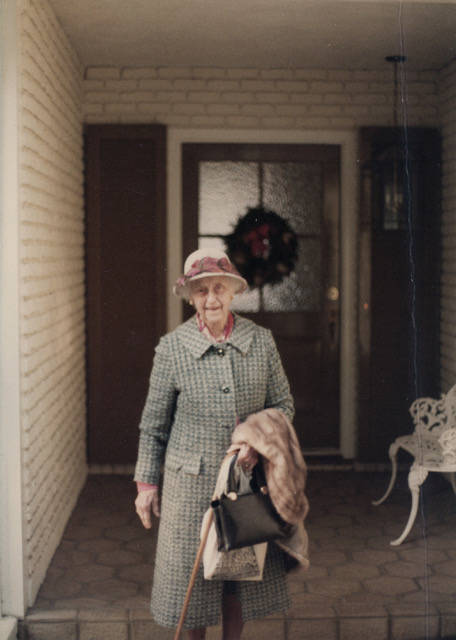She Put Her Head Down and Persevered
- Lucy Dinsmore

- Mar 22, 2019
- 7 min read
My great-grandmother was a woman who persevered in the face of family tragedy and challenging economic circumstances. Frances Vaughan Gardiner Finletter was born on September 16, 1892, and became one of the first women to be accepted into membership in the American Society of Landscape Architects (ASLA). She managed her own private practice, and was active in the profession for 55 years. Widely respected, when she was in her early 80s, she was named chairman of an at-large committee of the Garden Club of America. I just knew her as 'Ouma' - that's what we all called her. Our lives only overlapped for four years, but I remember the way she made us laugh and the flowery dresses she wore. Having little knowledge of her life's work, I tapped into my father and aunt's memories and various other sources. I hope you find this as fascinating as I did.
Education
Frances Vaughan Gardiner graduated from Bennett College in Millbrook, NY in 1912 with an Associate of Arts degree. She was independent, intelligent, and inquisitive. She also led a privileged life. Her family included prominent individuals in Philadelphia; one was a founding member of the American Philosophical Society, and another was a founder of the Franklin Institute. Since many of her male forebears had been school teachers or ministers, she was steeped in the tradition of learning, and committing to whatever you did.

Frances enjoyed gardening, and often worked alongside the gardener employed by her family. One day, that gardener said to her, “You know Ms. Gardiner, you love being out here with us - why don't you do something with this?” This struck a chord, and she decided to pursue an education in landscape architecture. However, no institution in Philadelphia would accept her as a degree-seeking student at that time. So, she enrolled at the Pennsylvania School of Horticulture for Women, one of the first horticultural schools established by and for women in the country. Founded in 1911, it provided women a practical education in horticulture and landscape architecture so they could enter a professional field. It was a two-year program, and she was part of the school's first graduation ceremony in 1915, one of only three graduates. The hands-on approach to learning included horticultural instruction on the following: orchard care, farm tool use, lawn and shrubbery care, care of livestock, botany, chemistry, vegetable and kitchen gardening, bee keeping, poultry raising, carpentry, and agricultural bookkeeping. The Pennsylvania School of Horticulture for Women merged with Temple University's Ambler Junior College in 1958, when men were admitted, and today the campus is part of Temple Ambler.
Family Life and Mental Illness
Frances was twice married, and twice widowed. As a young woman in her mid-twenties, she married Clement Charles Kite. They honeymooned in Yosemite National Park, where they did what they loved together - hiking, camping, and horseback riding. Together they had two children, before his untimely death in World War I. He was a U.S. Marine, and was killed at the Battle of Belleau Wood in 1918. At the time, their daughter Sallie was 22 months old, and their son Clement was only 2 weeks old. Frances was notified by the Marines of her husband's death, and then two weeks later, she received his last letter expressing his joy at the birth of their son. During that difficult period, she and her infants moved in with parents at their home in Chestnut Hill.

She remarried around 1925 to Edwin (Ned) Finletter, a prominent lawyer in Philadelphia. However, six months after their wedding, his behavior became "very strange and not himself." His mental health deteriorated, and Frances spent the next few years consulting specialists for his diagnosis and care. During the Christmas holiday of 1939, her son Clem was visiting during his senior year at Yale. The German Invasion of World War II had begun just four months earlier, and Clem was troubled by the idea of more boys becoming fatherless like he had during wartime. While Frances and the rest of the family were out on Christmas Eve, he ended his life, and the family found him upon their return. Frances' husband Ned died two years later in 1941 of a suspected brain tumor. She was widowed again, and also without one of her children.
"What I most appreciate about her," recalled my father, "is she put her head down and persevered in the face of family tragedy and challenging economic circumstances." Notwithstanding those tragedies, she had "a great sense of humor, loved a good joke, and was a terrific conversationalist."
Career in a Male-dominated Field
Going back to 1918, when she was widowed the first time and a single mother of two children, Frances had an optimistic spirit even then. She was working as a landscape designer, though not yet a member of the ASLA. She submitted her drawings and plans, and was accepted in 1932 as one of the first female members, before universities even allowed women to get degrees in the subject. She made a living at a time when she needed to. She had an office in center city Philadelphia that she shared with another female partner, and they maintained that location for a decade.
Her work focused on residential designs throughout the Philadelphia region, from the Main Line to Norristown, and Chestnut Hill to Mt. Airy. She also had a handful of projects in New England in places like New Hampshire and Massachusetts. One non-residential project Frances completed was the design for Charles & Helen Sigel Wilson's restaurant, L'Auberge in Wayne, PA (see images below). Frances only worked with clients she liked, or at least she came to like all of her clients. She didn't advertise, but received most of her business from word-of-mouth and reputation.
The Great Depression affected her practice, and while business didn’t dry up completely, it became very difficult. Frances fared financially, and even supported both her brothers, who were less financially stable. She was proud in her own right as a woman in her profession that was dominated by men. She had a fierce determination, and also loved what she did; it gave her enormous pleasure to see her designs develop and mature.
Frances remained a working member of ASLA until 1975, when she was granted emeritus status, and retired from practicing landscape architecture. For six decades, she was also a proud member of the Garden Club of America. There, she was also a member-at-large, an honorary position which included well-known architects such as Thomas D. Church of California.
Frances approached garden design with some steadfast principles. While not extraordinary, they show the care and thought with which she approached the landscape.
1. Choose plant materials well - consider shape, size, and price
2. Incorporate water features - small pools (preferably with fountains) were incorporated into most of her designs
3. Plan and plant for growth - design for 3-5 years out, not immediate satisfaction, and don't overplant
4. Prepare the soil - Never plant a $5 specimen in $0.50 soil. Always plant a $0.50 specimen in $5 soil.
In the trunk of her car, Frances kept a pair of brown leather shoes to wear at project sites. "They were always dirty," remembers my father. Additionally, she carried work gloves and pair of clippers in her car at all times, recalled my aunt Ann, who accompanied her on nursery and client visits. She was a wonderful teacher, and knew the Latin names for every plant. She shared her love of nature with her grandchildren through hiking, picnicking and traveling, and also going to nurseries, where they would wander around as she tagged specimens. She was a no-nonsense woman who knew how to deal with nurserymen and contractors. She was discriminating in the plants she specified, and would go to great lengths to find the best specimen.

Frances was fortunate to have the means to travel often in her life. She vacationed at a villa in Italy almost every summer, starting in 1896 when she was a four year old until 1980. Later in her life, she used the villa as a base for her travels, leaving her kids at home while she studied gardens in Italy, France, and England.
Later Life
Frances didn't fully retire until she was 83, doing little projects for family and friends. She had a group of very close friends, and together they were called the Gallivanting Grandmothers. This tenacious group took a road trip in 1956, and drove a Plymouth from Philadelphia to Mexico and around for six weeks. She was 64 years old. All her women friends were also widows, and there was a certain camaraderie they shared with one another. When asked by her granddaughter if she believed in God and church and all that, she once replied, 'Oh, Ann...you take what you need, Honey."
She lived in Chestnut Hill on Gravers Lane before retiring to Cathedral Village retirement community. My dad, aunt, and their family would visit her every Easter, and they would always be greeted by her her cheery window boxes full of pansies in all colors: yellow, white, blue, lavender, and purple.
Unfortunately, Frances and her daughter Sallie had a strained relationship. Sallie resented her mother's career and herself being the only one of her classmates with a “working mother.” This manifested itself in particular when Frances downsized and sold her house. During the move, Sallie cleared out her old studio and threw away all her old drawings and plans, leaving the family without any record of her works.
Frances Vaughan Finletter maintained her emeritus status with ASLA until her death on March 27, 1985. She lived to be almost 93 years old.
References
Carey, Jenny Rose, and Mary Anne Blair Fry. A Century of Cultivation 1911 to 2011: 100 Years from the Pennsylvania School of Horticulture for Women to Temple University Ambler. Temple University, 2011.
Dinsmore, Clem. Personal interview. February 2019.
Gralnek, Ann. Personal interview. 8 March 2019.
Obituaries. The Philadelphia Inquirer, 03 Apr. 1985, p. 74.
"Pennsylvania School of Horticulture for Women Historical Marker." ExplorePAHistory.com, http://explorepahistory.com/hmarker.php?markerId=1-A-130 Accessed 20 Feb. 2019.

















Lucy, this was an incredible read! She being a relative of a modern-day "woman in hort" makes it even more special. Thank you for sharing her story and work!